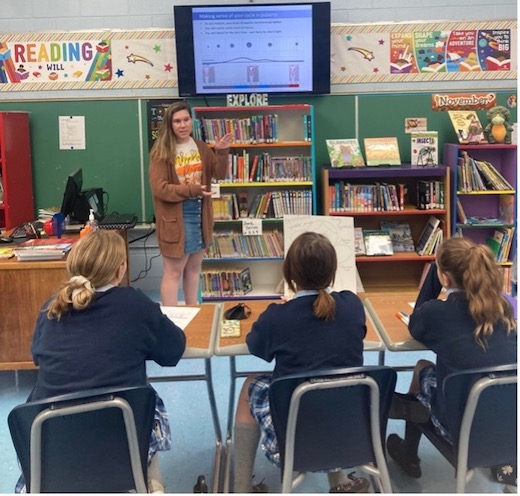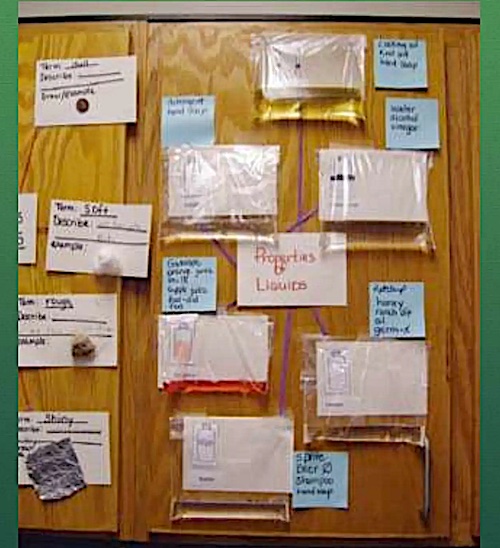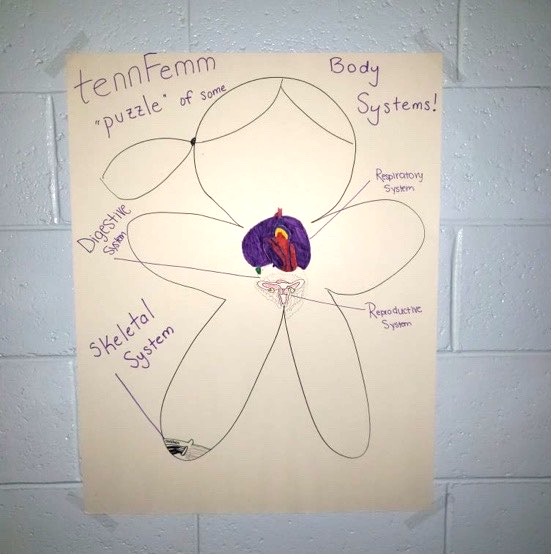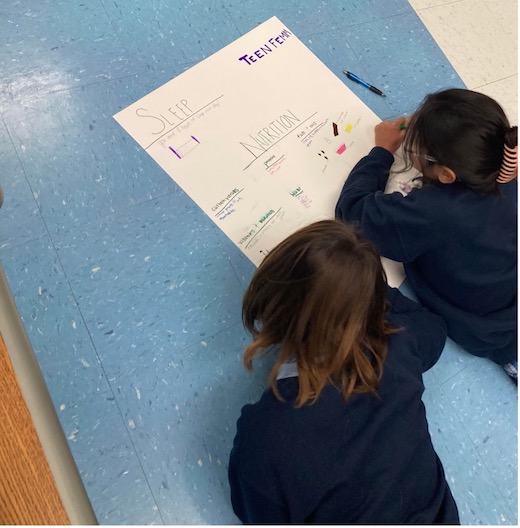Using Active Learning with Middle Schoolers
By Megan Reister, Brigid Utz and John Perozich
Have you ever wondered how you could incorporate multisensory learning in your classroom? Do you struggle to find activities to engage reluctant middle schoolers in learning?
When we were asked to help teach teenFEMM classes (a health and biology curriculum) to middle schoolers, we knew we wanted to incorporate co-teaching and interactive learning experiences.
We had so much success infusing hands-on learning in our classes that we wanted to share some teaching strategies we used for other educators to consider.
Our young adolescent girls grew excited to engage with the content we taught using active learning techniques, and we believe your students can experience the same sense of wonder and enthusiasm.
“Before – During – After” Strategies
We used a variety of strategies before, during, and after learning. Here are some examples.
► BEFORE: The bag-and-tag word wall activity.
A bag-and-tag word wall is a way to present vocabulary to students while providing an ongoing visual representation that can also be touched and felt (Amaral et al., 2006).
The word wall includes a visual representation of the word (in a bag) and a vocabulary label (a tag) to accompany it. Students enjoyed making contributions to bag-and-tag word walls. They can supply the items to be bagged, create the tags, and suggest relevant connections.
This method for teaching science vocabulary supports students across ability levels because all students are given an opportunity to personally interact with the objects on display. Seeing, touching, smelling, and hearing items creates a deeper understanding of science vocabulary words.
► DURING: The sketch-to-stretch activity (S-t-S).
Within this active learning strategy, the student draws an image (sketch) then stretches it out with key words used to describe the image (Bustle, 2004; Short et al., 2000).
The S-t-S is a great cross curricular activity, blending art (although artistic ability does not matter), writing, and the content or subject being covered (Farrell et al., 2020).
► AFTER: The windowpanes activity.
This is an effective strategy for developing vocabulary that incorporates visuals. A windowpane is a graphic organizer similar to an actual windowpane with equally divided sections that are typically used to introduce new vocabulary, organize information with key points, or describe a process (Husty & Jackson, 2008).
This activity may be used throughout a unit of study or as a summative assessment. In our curriculum, students were able to organize key concepts and reaffirm their new knowledge.
Students were given a piece of paper divided into eight squares and asked to write the vocabulary words in four of the squares. Next, students drew their own pictorial representation of what each word meant to them in the adjacent square before writing their own definition.
Once the definitions and visuals are inserted in the windowpanes, the teacher encourages students to discuss and view one another’s pictorial representations and definitions. This ongoing collaborative process supports student adjustments and creates a better product (Husty & Jackson, 2008).
Teachers also found that the addition of multisensory learning activities allowed for more checks for student understanding and more formative assessment opportunities.
Tips to foster and promote active learning
In addition to discovering what worked well for our students, we connected with other middle school teachers teaching the same curriculum and asked them to reflect on their most successful active learning teaching strategies. We’ve summarized all our reflections in these teaching tips:
- Reviewing the previous lesson allows for the teacher to scaffold and support student learning.
- Rephrasing, reviewing, and presenting material in a visual way assists students with understanding the concepts and material.
- Gain the students’ attention prior to introducing the material through a story or video clip that captures their interest.
- Promote student thinking by using open-ended and reinforcing questions to check for student understanding and to promote critical thinking. This can be done by asking “why” questions after students offer initial answers – encouraging elaboration and justification. In a specific example, the teacher noticed the students were very engaged in a modeling clay activity of creating the female reproductive system and had them answer “why” questions about their creations.
- Introduce vocabulary through a mystery bag strategy in which students have to guess, by using the sense of touch, what vocabulary words were represented by the hidden items stored inside the bag.
- Allow for movement in the classroom and let the learning spread across your physical space.
One teacher we worked with had this to say about our joint attempts to foster students’ curiosity and engagement with the material:
Students had the opportunity to ask the teachers many questions – both from their notes and spur of the moment questions. These questions were often “what” and “why” types of questions. Further, they were often open-ended and drew on prior lesson material showing the students were grasping the content and making connections.
It takes more time for teachers to incorporate hands-on experiences and active learning approaches. For some teachers, the time-intensive hands-on activities continued from one lesson to the next. They found that having the activities span two lessons increased student engagement and comprehension because the carry-over to the following lesson served as a refresher of the content being covered.
The benefits of using active learning
Including lots of hands-on activities was beneficial even though doing so created more teacher work. Our students maintained focus and attention and willingly participated in the active learning opportunities. Supplementing the instruction with active learning techniques led to the students being excited each week to see what the latest activity was going to be.
We saw that providing real-world examples and stories (including stories from our own lives) helped maintain their interest and engagement. We also noticed they maintained attention spans for a longer time compared to when we taught through a lecture that required them to sit for long stretches.
Another benefit we observed in our students was their perception of feeling seen and known within the classroom through active learning. One student said she could tell her teacher cared for her because the teacher was involved throughout. Another said her teacher made it clear the students could talk to her.
One student added that the teacher made her feel cared for because the teacher wanted the students to be healthy and to know about how their bodies work from a biological and health perspective.
Active learning across the curriculum
Our instruction was enhanced through our use of active learning approaches when implementing our curriculum. We believe that active learning can be used in any classroom, with any curriculum, and at any middle school grade level!
References
Amaral, O., L. Garrison, and M. Duron-Flores. 2006. Taking Inventory. Science and Children 43(4): 30-33.
Bustle, L.S. (2004). The role of visual representation in the assessment of learning. Journal of Adolescent & Adult Literacy, 47(5), 416-423.
Farrell, L., Osenga, T., Davidson, M., & Hunter, M. (2020, October 1). The Simple View of Reading. Reading Rockets.
Husty, S., & Jackson, J. (2008). Multisensory strategies for science vocabulary: Support learning about properties of matter for ELL and all students with these techniques. Science and Children, 46.4, 32.
Short, K., Kauffman, G., & Kahn, L. (2000). “I just need to draw”: Responding to literature across multiple sign systems. The Reading Teacher, 54, 160-171.
Dr. Megan Reister is a former hearing itinerant and special education teacher in Delaware and Pennsylvania and now enjoys conducting research and teaching as a Special Education and Early Childhood Professor in the Education Department at Franciscan University of Steubenville (Ohio). Her primary areas of research include self-advocacy in students, itinerant teaching, active learning, and fostering collaboration among parents and teachers.
Brigid Utz is a teacher with a B.S. In Middle Childhood Education. She is passionate about creating a positive and inclusive classroom environment that supports students’ holistic growth. She is a recipient of the Mary Lorenc Korzi Award for her research, service, and scholastic achievements in education and plans to pursue her M.S. in Special Education.
Dr. John Perozich has a BS in Biology from Lebanon Valley College and PhD in Biochemistry and Molecular Genetics from the University of Pittsburgh School of Medicine. He currently serves as Professor of Biology and Chair of the Biology Department at Franciscan University of Steubenville, where he has taught for 25 years.




































